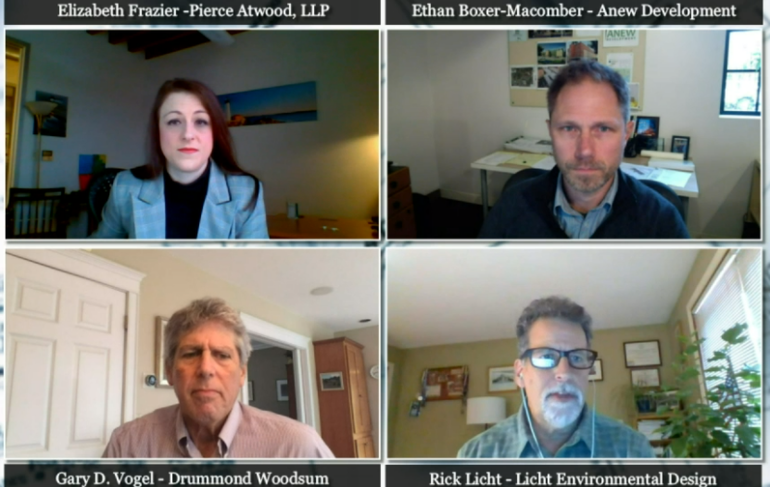For developers, the first step to a successful project: Do your homework
 Image / MEREDA video screen shot
MEREDA's Developer's Toolkit webinar took place Nov. 19 included, clockwise from upper left, Elizabeth Frazier, of Pierce Atwood; Ethan Boxer-Macomber, of Anew Development; Rick Licht, of Licht Environmental Design; and Gary Vogel, of Drummond Woodsum, MEREDA past president.
Image / MEREDA video screen shot
MEREDA's Developer's Toolkit webinar took place Nov. 19 included, clockwise from upper left, Elizabeth Frazier, of Pierce Atwood; Ethan Boxer-Macomber, of Anew Development; Rick Licht, of Licht Environmental Design; and Gary Vogel, of Drummond Woodsum, MEREDA past president.
Homework, preparation and communicating before a development project even hits the design table is the key to success, according to a recent Maine Real Estate and Development Association panel.
"There's a desire these days for people to just jump into a project and start designing it, and I think that's a mistake," said Rick Licht, of Licht Environmental Design, one of the panelists. "The due diligence phase and the concept planning phase of a project are the most critical for any project, especially if you want it to be anywhere near successful."
The panel was part of the launch of MEREDA's Developer's Toolkit, which provides resources to help smooth the permitting and approval process. The toolkit was created by the organization's Local Issues Committee and is available on MEREDA's website. It outlines what the approval process and provides outlines and templates to help navigate it, from project scoping through communications.
Besides Licht, panel members were Ethan Boxer-Macomber, of Anew Development; Gary Vogel, of Drummond-Woodsum, MEREDA past president; and moderator Elizabeth Frazier, of Pierce Atwood.
Members of the panel agreed that the initial steps a developer takes will set the stage for everything that comes after it. The major steps discussed, that are also covered in the toolkit, are project scoping, the local approval process and communications. But the general overview is that it's critical to know the project, as well as understanding its location and the people who live there well before the official process starts.
Project scoping
"In the modern world of development, it's important to make sure your project is the right fit for the community, both literally and figuratively," Frazier said.
Putting together a comprehensive project description at the outset will help a developer figure out where a project fits in a community, she said. That description should include a mission statement.
"It is important, and it will help frame your development," particularly in getting the community on board, she said. "The work you put in now really will pay off."
Some things are universal, no matter what the project size, Licht said. Getting together with the client and understanding the desired outcome is the "cornerstone" to communicating with the rest of the team, the municipality and the public.
"Jumping into a design too early is a mistake," he said. First, Licht said, the site itself should be considered. Does it need rezoning? Does it fit into a town's comprehensive plan? What's going on with utilities, soil, vernal pools and more?
"Understanding the neighborhood, reaching out the neighbors," Licht said. "What does the community think of this project?"
Initial building blocks include starting small and defining the project. If they don't work, the developer can walk away without losing much of an investment he said.
Building a team
The panel said building the right team is key to a successful project.
Essential members include engineers, environmental scientists, and others that have to be on board before a design can even be drawn. Licht said the developer should understand that there may be team members needed that they never considered.
Vogel said that looking at the town or city's regulatory issues first helps determine what initial steps to take, including picking a team. For instance, if there are road or traffic issues, a traffic engineer might be needed.
"Every project is different," Boxer-Macomber said, and needs a custom team. The architect who was great on the last project may not be right for the current one.
"The team needs to be very carefully crafted to make sure it's uniquely qualified to do the particular type of project. Whatever particular challenges your project might have, whether it's environmental, political, or legal, you need to find the best qualified to handle those particular unique aspects of your project," he said.
The team also has also has to understand the area where the project will be built, so that things will go well during review and permitting.
"Another mistake I see people making is trying to take their A team and transplanting them into a community where they've never worked before," Boxer-Macomber said. City and town codes are "technocratic and quite logical," he said. "But the process is political and can be quite unpredictable."
The developer needs technicians who can navigate the political waters, including the municipal staff and neighborhood personalities who will weigh in.
"Team selection is critical, and I think people need to sort of detach themselves emotionally from their team and think of it practically, because it is the most important decision in the process," he said.
Cooling hot button issues
Vogel said developers must look beyond what's required to see what the issues are.
"Often there is one hot-button issue that a project has to overcome," he said. "You want to focus on that early, right up front, and try to really get your arms around that so you can address those concerns."
An early sit-down with the planners in the town or city will help — the informal initial meeting is a good chance to find out what the issues are, who is important to reach out to in town and what the concerns of the staff are.
"You can have an open and very useful dialogue about the project," Vogel said. "Sometimes we have clients who think their project is going to be very easy, they think their project is the best thing in the world and everyone will love it. But we know that's not always the case."
The code enforcement officer is often a developers only one-on-one connection to the town, Frazier said, and it's important to know the person and communicate.
Boxer-Macomber said reaching out like that is important to get perspective on a plan.
While the plan may be good technically, "you have to look at this process through everyone else's lens as well in order to be prepared for what might come your way."
Boxer-Macomber was a planner before he became a developer, and said he's seen many instances where a developer is blind-sided by community opposition or a negative staff report. "This due diligence process, understanding the lay of the land, is critically important," he said.
"You don't want to show up at one of these meetings where you're forced to stand at a podium ... and suddenly your forced into this conflict you didn't know you were going to have," he said.
Watching previous planning board meetings online, to see how the board operates and what kind of things concern them, helps. He said he also likes to hold "pre-emptive neighborhood meetings" before the public meetings begin.
A good example, he said, is the Maine Cooperative Development Corp. and Szanton Co. Douglass Street project that got approval from the Portland City Council last week. A different project was favored by the city's Economic Development Committee, but the council choose the MCDC/Szanton plan. One major factor was the winning project got the Libbytown Neighborhood Association on board.
Communicating the idea
Frazier said communications "is where the rubber hits the road," as scoping and the local approval process come together.
She said real estate developers may not have a lot of experience with that part, but "it's not enough to check the boxes, but building support is critical," she said.
Sharing mission and location, important facts, having respectful counterpoints to opponents' arguments and being clear about the timeframe are all key points. Also important, she said, are identifying potential proponents and opponents is the foundation to a communications plan, then sharing the message either through neighborhood meetings or one-on-one meetings.
Licht said, in general, that communicating well involves "taking off the engineer's hat" and talking to people in normal terms they can understand. He said talking about "communities" rather than "subdivisions" is also important.
"It brings in the idea that you're trying to create something that's for the community," he said.
Boxer-Macomber said, "The most important thing is just to have a plan." Thinking through how to communicate "is the world's first introduction to your project."
He said things rarely go according to plan, so thoroughly thinking out the message and sticking to it is important.
Ultimately, the review process is a negotiation, he said. Knowing how much flexibility the proposal has, and and knowing the answers before issues arise will make the process work.
"It's going in with a plan," he said.
Mainebiz web partners
Great article!














1 Comments